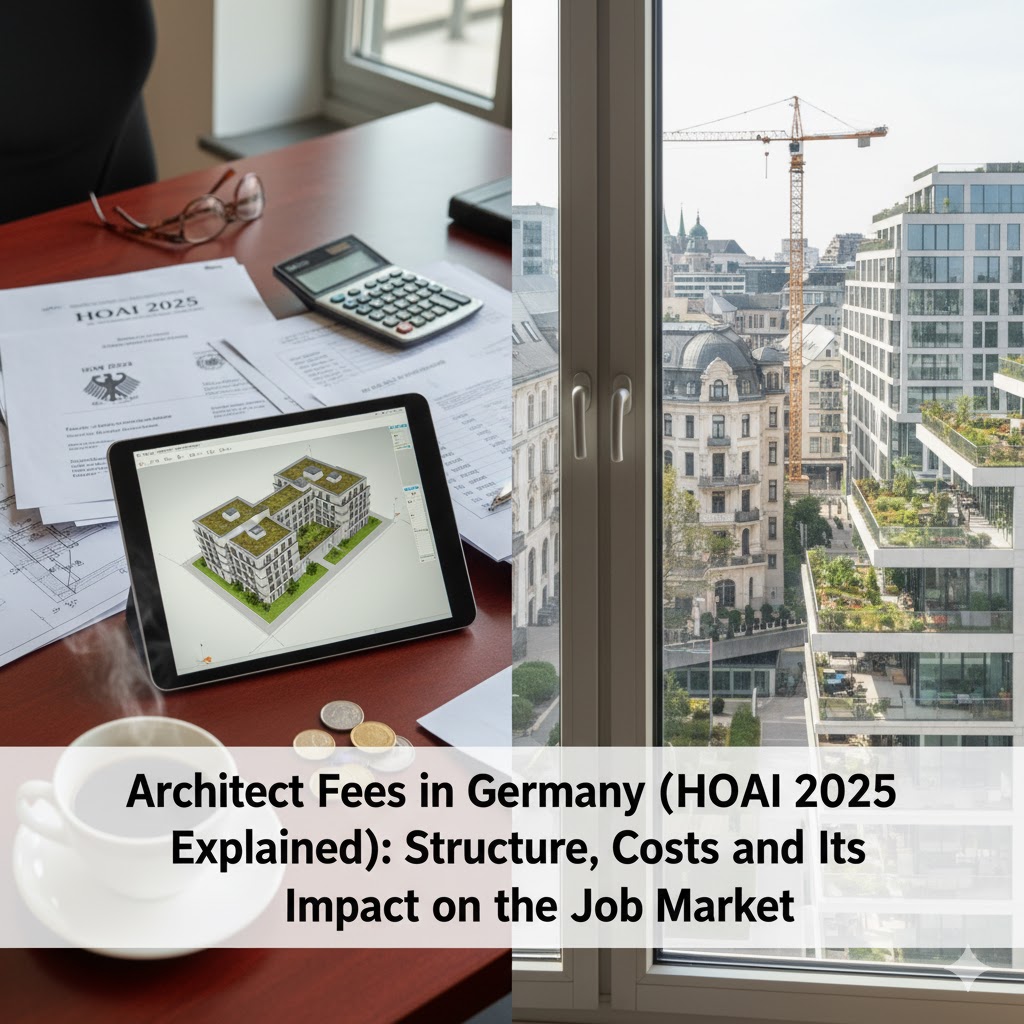Architect Fees in Germany (HOAI 2025 Explained): Structure, Costs, and Its Impact on the Job Market
In Germany, the HOAI (Fee Structure for Architects and Engineers) represents one of the most important frameworks in the architecture and construction industry. It not only defines the financial parameters of architectural projects but also ensures a balance between design quality, professional fairness, and client transparency.
The updated HOAI 2025 aligns with the current needs of the construction market — including digitalization, sustainability, and economic adaptation.
1. What is HOAI and Why Does It Matter?
HOAI is a legally regulated framework that sets minimum and maximum fees for architects and engineers according to project type, complexity, and construction costs.
It was first introduced in the 1970s and has been continuously revised to reflect changes in technology and market conditions.
The main purpose of HOAI is to prevent price dumping and unhealthy competition among architectural firms, promoting instead a culture of quality-driven design. For clients, HOAI ensures transparent and predictable project costs, creating trust between both parties.
2. Fee Structure in HOAI 2025
The 2025 edition maintains the traditional five performance phases (Leistungsphasen), with refined cost tables and updated fee flexibility:
- Basic Evaluation (Grundlagenermittlung) – Needs analysis and preliminary studies
- Preliminary Design (Vorplanung) – Concept design
- Design Development (Entwurfsplanung) – Final design phase
- Approval Planning (Genehmigungsplanung) – Permit drawings and documentation
- Execution and Supervision (Ausführungs- und Objektüberwachung) – Construction and site management
Fees are calculated based on construction costs (Baukosten), building type, and design complexity (Honorarzone I–V).
The 2025 revision allows greater flexibility in negotiations, encouraging tailored agreements between clients and architects.
3. Example: How Architect Fees Are Calculated
Let’s assume a client plans to build a 250 m² residential house with an estimated construction cost of €700,000.
If categorized under Honorarzone III (average complexity), total architectural fees range between 9% and 11% of construction costs — roughly €63,000 to €77,000, distributed across the design and supervision phases.
This transparent and staged system helps both parties understand cost responsibilities and minimizes financial disputes.
4. Key Changes in the 2025 Revision
The latest version of HOAI introduces several updates reflecting new industry priorities:
- Flexible fee range: more room for project-specific agreements.
- Digital design & BIM integration: BIM services are now officially recognized as part of the HOAI scope.
- Sustainability incentives: projects meeting DGNB or energy-efficiency standards can qualify for higher fee categories.
- Adjusted cost benchmarks: updated to reflect inflation and rising material prices.
In short, HOAI 2025 mirrors the transformation of architecture in Germany — toward a more realistic, digital, and sustainable industry.
5. The Impact of HOAI on the Architecture Job Market
Beyond cost regulation, HOAI also shapes the employment structure and skill demand in Germany’s architecture field.
Understanding HOAI has become essential for professional architects, not only for managing contracts but also for advancing their careers.
Firms increasingly seek professionals who combine design competence with contract and project management skills based on HOAI standards.
New job profiles have emerged — such as Project Manager (HOAI Expert), Cost Planner, and Design Coordinator.
Moreover, as BIM and digital workflows become officially integrated into HOAI, roles like BIM Manager and Digital Architect are gaining stronger recognition and stability in the market.
Thus, HOAI serves not just as a fee system but as a map of professional value distribution within Germany’s architecture industry.
6. Recommendations for Clients and Architects
For clients, understanding HOAI helps avoid unexpected expenses and allows precise financial planning.
It is recommended to clearly define fee stages and responsibilities within the contract.
Architects, on the other hand, should document and justify their services in alignment with HOAI — protecting their professional and financial position.
Collaborating with offices familiar with HOAI, such as Aron Studio, ensures smoother project coordination, especially in international or cross-cultural contexts.
Conclusion
HOAI is more than a pricing framework — it is the shared professional language of Germany’s building industry.
The 2025 edition introduces flexibility, digital competence, and sustainability at its core.
For architects, mastering HOAI means unlocking stable and fair career paths.
For clients, it guarantees transparency, accountability, and trust.
As Germany’s architectural landscape evolves, HOAI 2025 stands as a foundation connecting tradition, technology, and professional integrity.
Building Permit Process in Germany: Step-by-Step Guide (2025)






